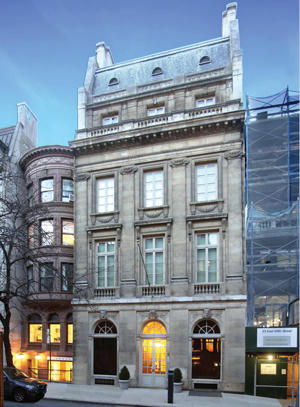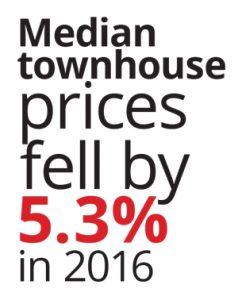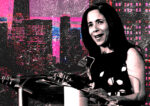The sale of art heir David Wildenstein’s $79.5 million

Wildenstein mansion
Upper East Side mansion in early April serves as a beacon of hope for townhouse sellers who have struggled amid a feeble market.But does it necessarily mean the townhouse market is on the rebound?
Some townhouse brokers said they’re actually concerned that the sale could result in a further widening of the gap between sellers’ price expectations and what buyers are actually willing to pay, thereby stalling sales once again and throwing the market into a fresh state of disarray.
“Every seller will come out the door and say, ‘Well they got $79.5 million, therefore I’m worth several hunks more of gold than I was yesterday,’” said luxury broker Paula Del Nunzio of Brown Harris Stevens, noting that the Wildenstein property took four years to sell. “All the owners will think it’s a comp, and all the buyers will say, ‘No way!’”
A string of big-ticket sales in recent weeks has fueled speculation that the townhouse market could finally have turned a corner after more than a year of gridlock. Median townhouse prices fell by 5.3 percent last year, to $4.97 million, and the number of days a property spent on the market averaged 164 in 2016, up by 47 percent from the previous year.
First, real estate investor Andrew Farkas sold his Upper East Side manse in February for $41 million, taking home an $18 million profit after buying the house at 12 East 73rd Street for $23 million a decade ago. That deal was followed by the $41.5 million sale of Japanese billionaire Bungo Shimada’s house at 7 East 76th Street to imprisoned Chinese billionaire Huang Guangyu in March. The Wildenstein sale is the third to cement the trend.
Brokers with listings at the very top end of the market are already pointing to the sales as evidence of a rebound.
“Does it automatically mean property is worth more? No. But [sellers] should have more confidence because the market is transacting at all levels, even the upper echelons,” said Matt Lesser of Leslie J. Garfield & Co., citing the recent sale of 269 West 11th Street, a 27-foot-wide house that sold for $27.4 million in February, just 14 months after trading hands for $20 million.
Some agents say they’re already seeing concrete evidence that the market is turning.
“We’ve already seen the interest pick up in the last 30 days, since those closings,” said Adam Modlin, who is listing a townhouse for $84.5 million at
8 East 62nd Street on behalf of developer Keith Rubenstein. “The seller is seeing the recent trades in the market and how the market has ceded up. They’re actually considering raising the price. Buyers always look for data and a benchmark. Now, for the first time, you have three townhouse sales that people can use as that benchmark.

Dexter Guerrieri, president of Vandenberg, said he’s also seen townhouse sales rebound over the past few weeks after 18 months of lackluster activity that he chalked up to an uncertain political climate. Over the past two years, he’s seeing more “end users” step up, rather than speculative investors who may have had trouble selling their listings.
Modlin said he doesn’t believe the Wildenstein sale will result in unrealistic seller expectations since it didn’t set a record on a price-per-square-foot basis. The townhouse sold for about $3,180 per square foot,
though sources said the buyer, Chinese conglomerate HNA, will have to invest much to bring it up to scratch. The company is reportedly planning to use the property as a corporate office rather than returning it to its original purpose as a single-family home.
“When that sale at 15 Central Park West came close to $10,000 per square foot in 2011, everyone put their properties on the market for $10,000 a foot, which was crazy,” Modlin said. “In this case, the number and the record is really attributable to the size of the house and the square footage.”
Others said the fact that HNA plans to convert the property into an office makes it more difficult to use as a residential comp. The deal may say more about HNA, which recently entered contract to pay $2.2 billion for office tower 245 Park Avenue, and its designs on making a splash in New York than on the strength of the townhouse market, said Paul Purcell of William Raveis NYC.
“It’s the same as a retail store,” Purcell said. “Why is Armani on Madison Avenue? Why is Hermes on Madison? It’s not to sell product, as much as to have a presence, an image and a brand. It’s a corporate statement. We’ve arrived and we want to show everybody.”
But Purcell and others cautioned that a concentration of three big-ticket sales won’t necessarily trickle down to the rest of the market. The sample size is too small, he said.
“When there’s a sale like the Wildenstein mansion, it’s interesting, but it has very little to do with the typical townhouse market,” said Guerrieri. “It’s an outlier until we get others that are relatively similar.”
But even if the Wildenstein sale is a one-off, the general consensus among brokers is that things are looking up.
“It definitely sends out a clear message that the townhouse buyer is alive and well,” said Compass president Leonard Steinberg. “It’s a record price, which says the high end is back.”



